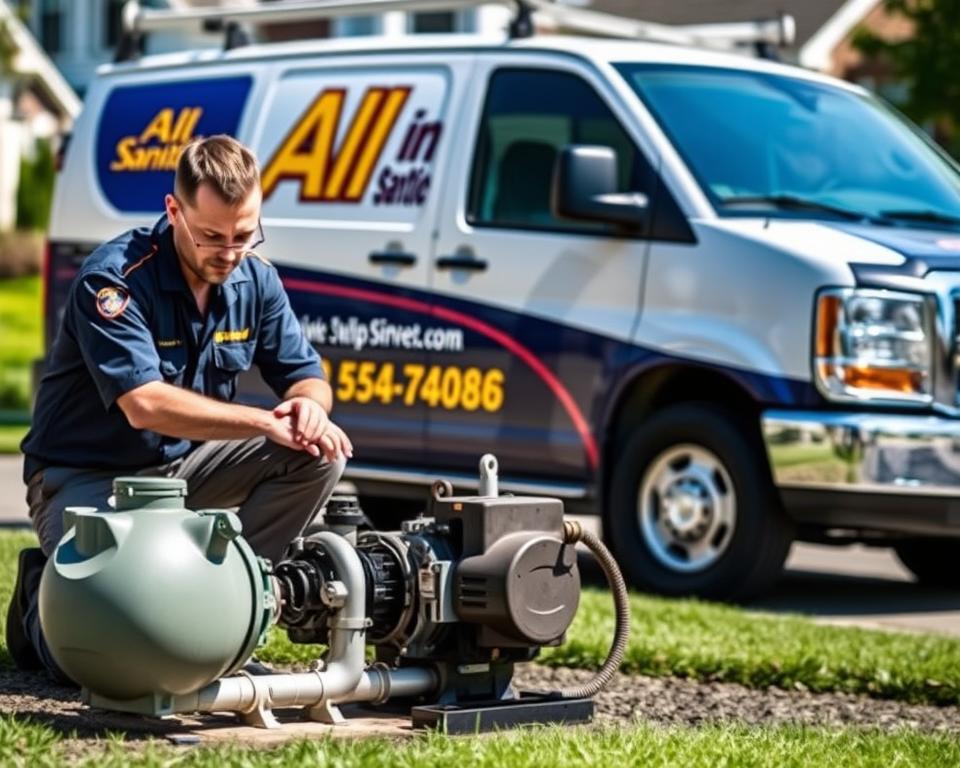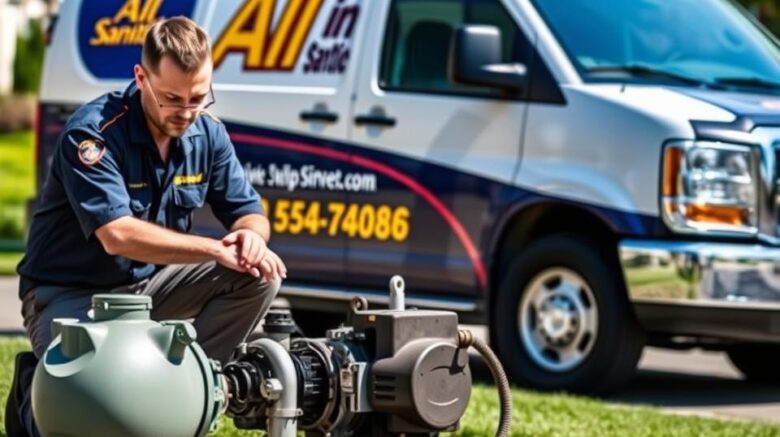Septic Aerator Pump: Complete Guide for Householders
Curious about what enhances your oxygen-based Septic system’s output? The air Pump in your Septic system is the often-overlooked champion vital for your system. Throughout this overview, you will obtain practical knowledge on the device’s function. It’s key for a sound, effective Septic tank.
Understanding the value of a Septic tank air Pump can boost your Septic system’s functionality using septic tank cleaning companies. It also preserves your property’s value and local environment. The following guide will introduce All in Sanitation, a leading Septic industry authority. They’re ready to serve your Septic aerator Pump requirements.
Summary Highlights
- The Septic air Pump is crucial for aerated wastewater units.
- Properly caring for your Septic system air Pump can boost overall system performance.
- Routine inspections extend the longevity of your Septic tank air Pump.
- Choosing the proper Septic aerator Pump is key for maximum operation.
- All in Sanitation delivers tailored services for Septic air Pump solutions.
Understanding Aerobic Septic Solutions
Aerobic Septic systems present a enhanced waste treatment method by using oxygen. This technique relies on aerobic bacteria living in well-oxygenated environments. These bacteria are faster in breaking down organic matter. With the help of Septic aerator Pumps, these systems maintain a steady oxygen supply, accelerating the waste decomposition process.
These systems stand out in lowering sludge buildup, because of the effectiveness of aerobic bacteria. This drop in solid waste means less maintenance and periodic Pump service is required. Additionally, they successfully handle wastewater, creating barely any odor. This yields a improved environment for homeowners and the community together.
To make sure these systems function smoothly, it’s crucial to know the key Septic system components. These include the Septic tank, oxygenation chamber, and effluent Pump. Each component is vital, especially the air Pump. It pushes oxygen into the tank, essential for the aerobic bacteria’s effectiveness.
Significance of the Septic Air Pump
The Septic air Pump is key in the functioning of aerobic Septic systems. It serves as the system’s “lungs,” providing the necessary oxygen essential. This oxygen enables aerobic bacteria to prosper and break down waste efficiently. If the Pump malfunctions, the system’s performance drops, bringing about sludge increase and possible odors.
Such issues can hamper Septic system operations and lead to environmental hazards. By understanding how essential the Septic air Pump is, homeowners can take proactive steps. They can ensure its peak function through routine care. This wards off failures, avoids costly repairs, and preserves the aerobic system’s condition.
Primary Gains of Using a Septic Air Pump
Operating a Septic air Pump markedly increases the capability of Septic systems. Septic air Pumps are crucial as they accelerate the processing of waste. This is achieved by oxygenating the treatment process, promoting aerobic bacteria growth. These bacteria are necessary for efficient waste treatment.
They’re also important in reducing foul smells. Because of more active aerobic processes, waste is treated faster, thus reducing odors. This ensures better surroundings for homeowners.
Another valuable benefit is the cut in sludge buildup. Consequently, tanks require less frequent Pumping, cutting both money and time. Greater processing not only saves costs but also extends the lifespan of the drain field.
Maintaining these Pumps well means minimal repair costs and complying with regulatory standards. Thus, the pluses of Septic air Pumps extend past for homeowners. They also support environmental health by advancing waste management practices.
| Benefit | Description |
|---|---|
| Fast Waste Breakdown | Greater aerobic activity accelerates the decomposition process. |
| Minimized Odor Emissions | Superior treatment efficacy results in fewer odors. |
| Reduced Sludge Buildup | Fewer Pumping and maintenance are needed. |
| Extended Drain Field Life | Better treatment translates to a healthier drain field. |
| Cost Savings | Lower chance of repairs and regulatory compliance cost. |

Choosing the Right Septic Air Pump
Choosing the best Septic air Pump is vital for an optimized aerobic system. Homeowners must consider various factors for the ideal match. The dimensions of the tank and the airflow specifications significantly influence the Pump’s efficiency.
To select well, it’s helpful to be aware of the air Pumps available. There are mainly two types: diaphragm Pumps and rotary vane Pumps. Each provides distinct advantages, which should be paired with your home’s particular demands and how it operates.
Energy efficiency also should be considered. Picking a Pump that cuts energy use while providing the needed airflow can yield lower utility bills. Assistance from All in Sanitation professionals can be extremely useful. They make certain the Pump you choose meets your system’s requirements seamlessly.
Common Types of Septic Air Pumps
Homeowners can choose intelligently by being aware of the multiple Septic air Pumps available. There are mainly two types: diaphragm Pumps and rotary vane Pumps. Each has its specific functions and benefits.
Diaphragm Pumps, noted for their hushed operation, are popular for residential Septic systems. They maintain energy efficiency while ensuring stable air output. Their constant performance matches smaller systems, appealing to many homeowners.
Rotary vane Pumps, however, are designed for higher-capacity or commercial systems. These Pumps produce increased power, necessary for handling bigger loads. Their strong build allows efficient operation in heavy-duty Septic systems.
| Type of Pump | Best Use | Advantages |
|---|---|---|
| Diaphragm Pumps | Residential Systems | Quiet operation, energy-efficient, reliable air flow |
| Rotary Vane Pumps | Larger or Commercial Systems | Powerful performance, high capacity, durable construction |
Knowing the distinctions in Septic air Pumps is important for upgrades or replacements. Each Pump type offers particular attributes to meet various needs. This ensures best performance for any system.
How to Tell You Need a Septic Air Pump Replacement
Homeowners must look out for Pump failure signs in their Septic systems. Some signals point towards the need for a Septic air Pump replacement. These support reliable function. Spotting these promptly avoids serious issues.
Signs of potential problems include:
- Unusual noises from the Pump, like rattling or trembling, might mean internal damage.
- A clear lack of air output indicates the Pump isn’t working well, reducing efficiency.
- Ongoing electrical problems, such as blown fuses or lights dimming, could show overloading.
- Visible damage on the Pump unit, with fractures or leaks, requires quick action.
- Bad smells in the yard often signal a compromised Pump, meaning ineffective effluent aeration.
Recognizing these signs early prevents expensive repairs or total system failure. Conducting periodic reviews assists in finding these issues. It also shows if you ought to have a new Septic air Pump.
Care Guidelines for Your Septic Air Pump
For an effective Septic air Pump, periodic care is crucial. This ensures that your system works smoothly. Homeowners can use several straightforward care strategies for best results.
Twice a year, carry out a thorough inspection for wear or damage. It is also essential to replace the filters as suggested. This prevents clogs that could reduce efficiency.
The Pump should be placed on a steady base to cut vibrations, which could damage it over time. A protective cover is critical too. It protects against debris and water, preserving the Pump’s functionality.
Proper maintenance can considerably increase the life of your Pump. In turn, this helps the Septic system’s performance collectively.
| Maintenance Task | Frequency | Benefits |
|---|---|---|
| Inspect Pump for damage | Every 6 months | Catches problems quickly |
| Replace filters | As needed | Improves efficiency |
| Check surface stability | Annually | Reduces vibrations |
| Clear debris around Pump | Monthly | Avoids obstruction |
Fitting Your Septic Air Pump
Correct installation of your Septic air Pump is critical for its optimal operation. Initially, pick a stable, moisture-free area for placement. The chosen spot should reliably bear the Pump’s weight with ease.
To successfully fit your Pump on your own, observe the following guidelines:
- Assemble all necessary items, including the Pump, a power source, and hose fittings.
- Carefully read the manufacturer’s guidelines before starting your installation.
- Verify every connection is secure to avoid air leaks that impact performance.
- After assembly, conduct a test to ensure the system works as intended.
If the installation process looks challenging, call All in Sanitation. Their professionals can avoid common errors, making sure your setup follows relevant safety requirements.
Advantages of Using All in Sanitation for Your Septic Air Pump Requirements
When deciding on a Septic service provider, the choice is important. All in Sanitation differentiates itself by providing dependable Septic air Pumps. They address varied homeowner requirements with a broad selection of quality products. This makes sure customers discover an perfect match for their Septic systems.
What clearly distinguishes All in Sanitation is in addition to their extensive product lineup. Their dedication to exceptional customer service is just as important. Homeowners get professional guidance, guiding them towards trusted Septic solutions. This teamwork is important to adapt each solution to fulfil specific needs.
All in Sanitation also emphasizes aftercare to secure lasting satisfaction. Their promise extends beyond the initial sale. They supply ongoing support to keep Septic systems functioning optimally for the years ahead.
Financial Aspects for Septic Air Pumps
Appreciating the price factors associated with Septic air Pumps is key for homeowners who run aerobic Septic systems. At first, one faces the buy-in cost, which includes the Pump and required accessories. Installation expenses fluctuate, in line with the system’s complexity and any changes required.
Ongoing upkeep forms an additional cost layer. Regular inspections can ward off bigger issues, ultimately leading to savings. Homeowners should budget for Septic maintenance to maintain the Pump’s effectiveness and service life. Such planning avoids expensive repairs later on, showing the advantage of proactive maintenance.
| Cost Component | Average Cost Range |
|---|---|
| Septic Air Pump | $500 – $1,200 |
| Installation | $300 – $800 |
| Annual Maintenance | $150 – $400 |
| Potential Repair Costs | $1,000 – $5,000 |
Itemizing Septic air Pump expenses into distinct parts supports homeowners in budgeting. This comprehensive approach guarantees the system’s steady performance and their confidence.
In Summary
For homeowners with aerobic Septic systems, caring for Septic setups is key. The appropriate Septic air Pump optimizes waste processing and increases your system’s life. Scheduling ongoing care and swiftly handling issues sidesteps costly fixes and disruptions.
Opting for a Septic air Pump warrants consideration. This guide showed how to decide intelligently about installation and replacement. With All in Sanitation’s help, you can tackle your Septic systems’ complexities with confidence.
Looking after your Septic air Pump improves your system’s functionality and service life. It ensures a efficient and proper operation over time. Don’t forget, your home’s wastewater management is greatly improved by consistent upkeep.
